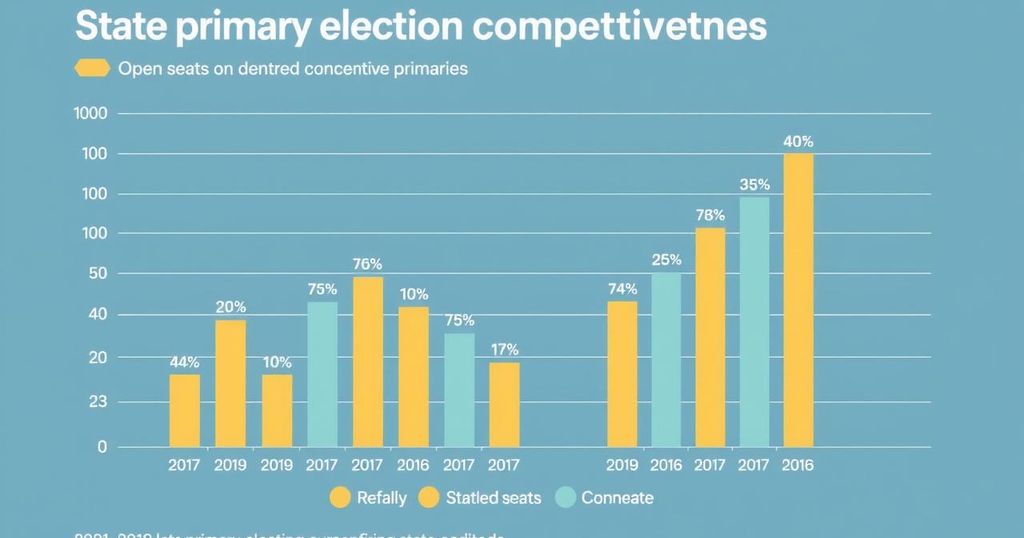A Look Back at 2025 State Primary Election Competitiveness

- 2025 had the lowest percentage of open seats since 2011.
- Contested primaries in 2025 fell to 17.6%, lower than past years.
- New Jersey’s incumbents faced the most electoral challenges this year.
- No incumbents lost in state executive elections across the three states.
- Only three legislative incumbents were defeated in New Jersey this year.
Understanding the Trends in State Primary Elections
An Overview of 2025 State Primary Election Competitiveness 2025’s state primary elections revealed some noteworthy trends in the political landscape. This year, the total share of open seats dropped to just 5.9%, the lowest seen in odd-numbered years since 2011. Also, the competitive nature of the primaries saw a decline, with only 17.6% being deemed contested, which is lower than the average of 19.7% recorded in the years running from 2011 to 2023. The race for incumbents also showed subtle variations, with a relatively slight increase in the percentage contested at 22.4% compared to the previous average of 21.8%. It seems the calm waters of this year may hint at larger shifts on the horizon.
Incumbent Performance and Yearly Shifts in Defeated Seats
Highlights from New Jersey, Virginia, and Wisconsin This year’s primary elections spanned across three significant states: New Jersey, Virginia, and Wisconsin. Notably, New Jersey conducted primaries for key political offices including governor and the General Assembly, while Virginia had not only a gubernatorial primary but also for positions like the lieutenant governor, attorney general, and members of the House of Delegates. Meanwhile, Wisconsin moved ahead with a non-partisan primary intended for the superintendent of public instruction. Together, these states held 51 primaries out of a potential 289 across 185 seats open for election, indicating a relatively condensed electoral field this year. In these races, state executive incumbents managed to hold onto their positions without any losses, though three incumbents did fall victim to challengers in New Jersey’s state legislative primaries.
Sharing Insights as We Move Forward
Incumbent Losses Provide Insight into Future Elections Of the incumbents up for re-election in New Jersey, three, all Democrats, faced defeat in the state legislative primaries. This amounts to only 1.7% of all incumbents who sought to maintain their positions, or 7.9% in the specific contested primaries. A total of 172 legislative incumbents armed with intentions for re-election ran in New Jersey and Virginia, and the results this year mark the third-fewest number of incumbents defeated in odd-numbered cycles since 2011, trailing only behind 2017 and 2013. The current outcomes beg the question of whether a more competitive primary environment lies ahead in 2027 or if the landscape will remain stable for incumbents going into the next election cycle. It’s a pivotal period for both parties as they prepare for future contests in a landscape that presents both challenges and opportunities.
Reflections on Historical Trends and Future Outlooks
In sum, the 2025 state primary elections in New Jersey, Virginia, and Wisconsin exhibited a marked decrease in competitiveness with fewer open seats and contested races. With incumbents largely securing their positions, especially at the executive level, it raises interesting questions about the general political climate leading into the next round of elections. While some may find security in the stability of incumbency, others wonder if this will change when the campaign heats up in 2027.
To wrap it all up, the 2025 state primaries presented a unique snapshot of electoral dynamics, showcasing a clear decline in both open and contested seats compared to past years. The incumbents remained predominantly unchallenged, save for a few notable exceptions in New Jersey. This year’s results might trigger more questions than answers as the political environment moves toward the next election cycle. The implications of this year’s turnout merit consideration as we await the evolving nature of competitive races in coming years.







